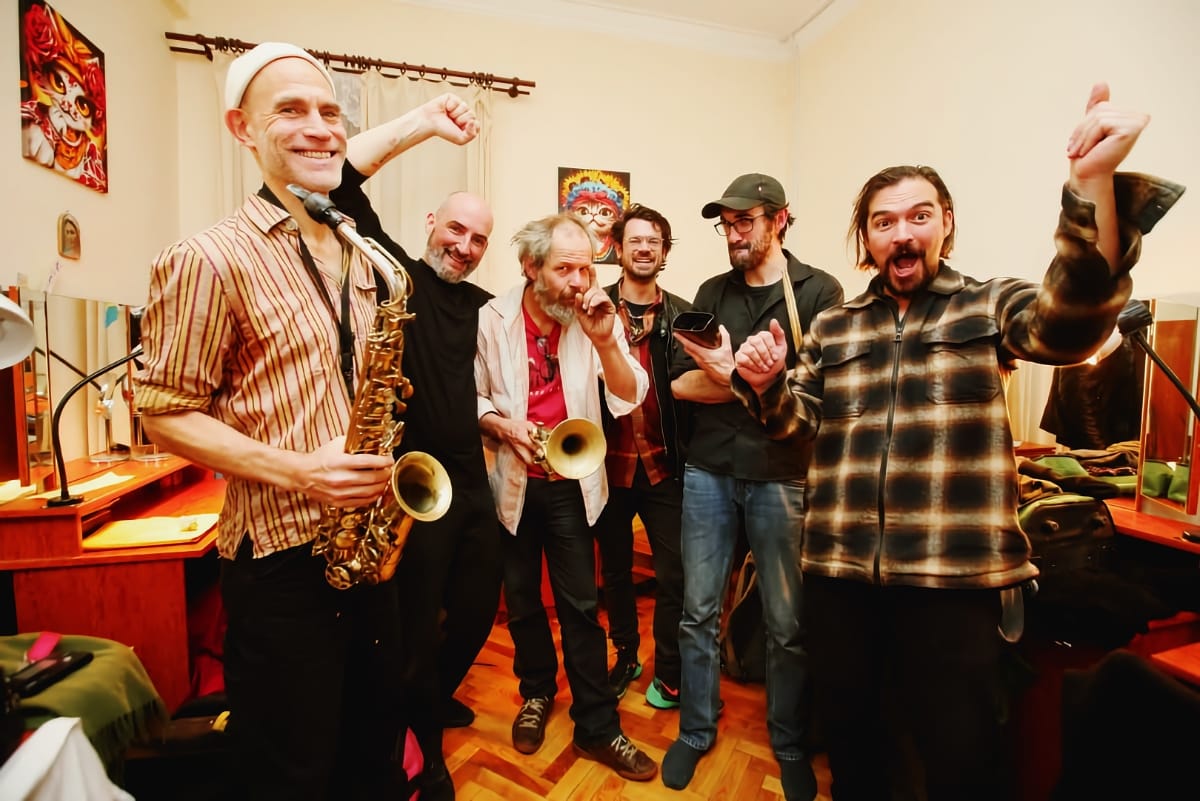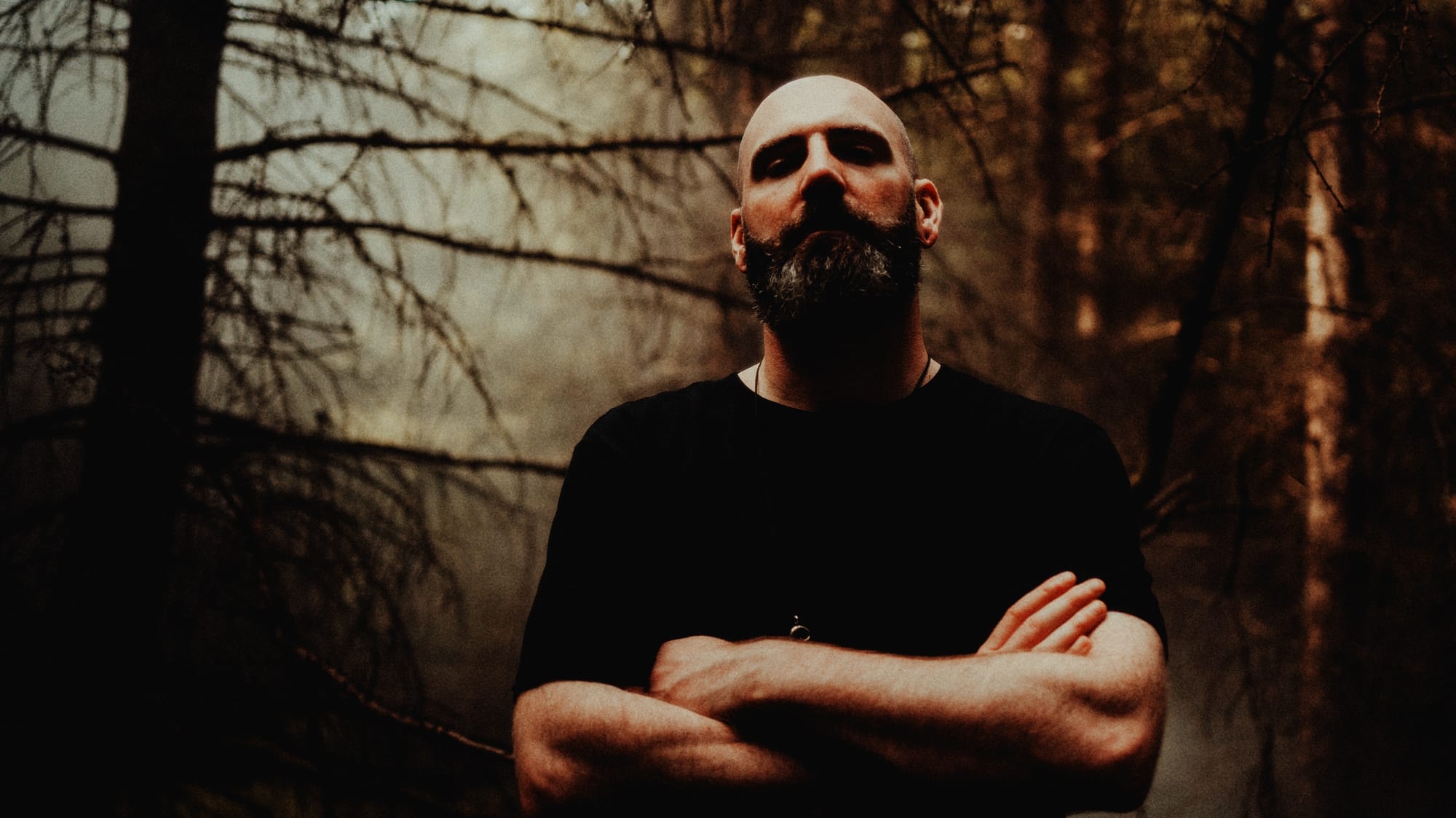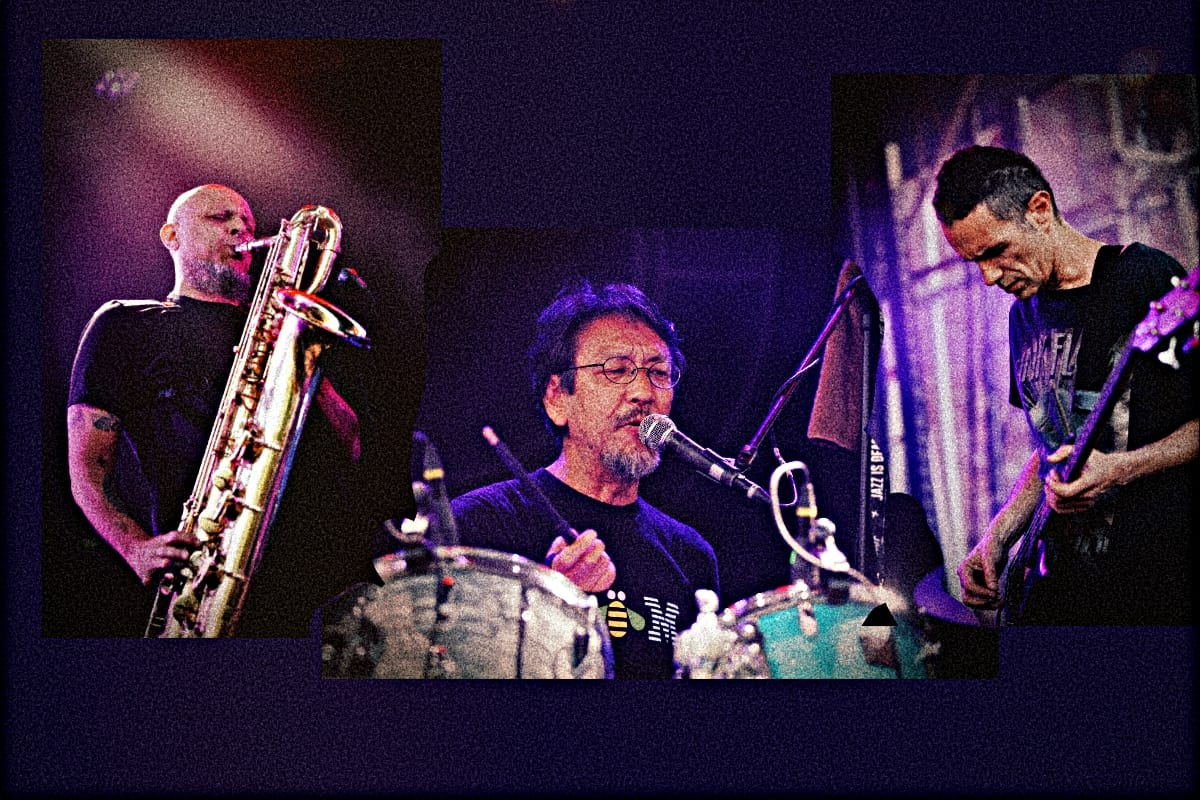Instead of colliding, the vibrant worlds of Zu and Ruins fused to form a moment of dazzling avant-garde madness, with the collaborative frenzy captured on a live recording from their set at the Jazzisdead Festival '24 in Turin, Italy. Zu bassist Massimo Pupillo and saxophonist Luca T. Mai joined forces with the legendary Ruins drummer/vocalist Tatsuya Yoshida to conduct this awe-inspiring event, released via Subsound Records as Jazzisdead Live.
Yoshida, hailing from Japan, carries an impressive reputation for being a fiery multi-dimensional artist, concocting mind-bending works of jazz, funk, and rock since the 1980s. Zu, representing Italy, are no slouches either, wowing listeners with their abrasive forms of jazz, funk, and progressive rock dating back to the '90s. It was only a matter of time until these two kaiju would synchronize.
Ruins and Zu have toured together over the years, but it was recently when Yoshida approached the Italians, at first, to devise improvised sets. Seeing how fun and successful this venture was, the two decided to turn things up a notch and tour as one, playing select songs from each other's catalogs and creating intriguing renditions. The Jazzisdead Live recording displays the collaboration in its most solid form, following more than twenty gigs across Europe. Pupillo reports on the budding legacy of RuinsZu in this interview.

Michael Centrone: How did the collaboration with Tatsuya Yoshida finally come together initially?
Massimo Pupillo: We have been friends with Yoshida-san since the '90s. The two bands toured together and knew each other very well. We didn't stay in touch for a few years until a couple of years back when Yoshida wrote to me out of the blue, asking if I wanted to play three improv shows with him. These shows went so well that we thought to try something more ambitious, such as playing the back catalog of both bands, rearranging them, and going on a full-scale tour.
Michael: What musical and songwriting challenges came with the collaboration?
Massimo: On my side, learning the bass parts took me three or four months, several hours per day, and some parts were really challenging until the tour when they became much more familiar and easy, so I could finally forget the technical part and just go for it.
Michael: What about those bass parts made them difficult to learn and master?
Massimo: Well, Ruins are as advanced as it gets, as far as I'm concerned—language, intricacy, timings, and speed. Everything is innovative and so well-delivered. We met lots of musicians and bands that they influenced. Ruins are light speed, furious delivery, but also absolute precision and accuracy at the same time. It's like extreme metal, extreme hardcore, and extreme prog all at once.
Michael: What were some surreal moments getting to collaborate with Yoshida?
Massimo: Yoshida-san is very Japanese, and we are very Italian. I'll let you guess. He's very reserved; we are all over the place. But we respect each other a lot, and I think it was a very good experience for everyone involved.
Michael: With the cultural differences, how did you guys create a common ground to jam from? Were you nervous at first to jam with him?
Massimo: Yes, I was very nervous until the first couple of shows. The beauty of music is that it transcends the limits of culture, and I know it's a platitude, but, really, it is a universal language. Maybe it's THE universal language. So, this was never a problem. I could say that lots of Japanoizu stuff influenced Zu, and at the same time, Yoshida is influenced by lots of old Italian prog, so things come full circle!

Michael: Why did you choose the Jazzisdead Festival performance for the official live album?
Massimo: We didn't really choose; it was a lucky chance that it was the last show of the tour, so we arrived in full shape, and they had recording facilities. As many times before, we didn't choose but just discovered something.
Michael: Would you say the Jazzisdead performance was your best of the tour? Why or why not?
Massimo: When you play every night, your set tends to get better and tighter. On top of that, the technical conditions at the Jazzisdead Festival were top-notch. Plus, three thousand people attending our show made quite an impact on the performance, I guess!
Michael: What were some of your highlights from the festival?
Massimo: As I told you, it was the last show of twenty-three, almost in a row, and getting to see Godflesh right after our set was the cherry on the cake of the tour for me.
Michael: Who or what inspired the theme for "La Grande Madre Delle Bestie"?
Massimo: This is a very great question. Thank you. On the inspiration side, it comes from a Euripides theater play. On the musical side, there are humble traces of our obsession with The Rite of Spring by Igor Stravinsky.
Michael: Are there actual song lyrics, or is Yoshida just complementing the music with random vocals?
Massimo: Yoshida-san always sings in his created cosmic and multidimensional language.
Michael: What is a funny or interesting story from the tour?
Massimo: Looking for Asian buffet places all over Europe.
Michael: Why was trying to find these buffets such an adventure?
Massimo: It was just a lot of fun to share Asian buffets with Yoshida-san around Europe. This became a tour joke. But, in general, what made this tour special was that we decided that Yoshida-san would choose which Zu tracks to play, and we would choose the Ruins tracks, which made it already start in a very exciting and creative way.
I was probably more literal in learning his music exactly how it is on the records, while Yoshida was more free and chose to rearrange parts or most of Zu according to his vision, which added more excitement. Also, the difficulty bar was raised again!!
Michael: What is the secret to your gravelly bass tone?
Massimo: I would say it's my intention of the sound I want to get from the instrument. Of course, there are pedals, a specific amp, a cabinet, and a great bass guitar that I love, but I suppose that intention is key.
The bass is a Jaydee Supernatural bass guitar made by John Diggins in Birmingham in the early '80s. I own two of them, and they are my only bass guitars. I don't need anything more; I love them to bits. Also, they are both heavily modified and customized, so they are not at all collector's items but made-to-measure. One is the guitar I always use, and the other is a spare. They are both great in sound and feeling.
Normally, I use an open tuning, but with RuinsZu, I went back to standard tuning. So, the bass guitar goes into a pretty full, messy, and always-changing pedalboard that, at the moment, has a tuner, distortion, EQ, a very solid preamp, a bass whammy, a suboctaver, a chorus/flanger, an analog delay, a compressor, and a looper. Then, the signal goes into a '70s Traynor Monoblock B amp.
Michael: What were some interesting crowd reactions while on tour?
Massimo: It was great. We didn't expect that people had longed so much for Zu and Ruins to be back, that this music still means a lot to many, and it's still so capable of causing excitement and fire. It felt like we were filling a void.
Michael: What kind of words and feedback have you gotten from audiences?
Massimo: The simple fact that people had waited for us to come back after years of silence and showed their enthusiasm and often told us that no one else had taken our place for them made us regain a lot of strength and enthusiasm. We felt this every night just by the audience's reaction.
Check out more Zu at zuism.net and explore Ruins on their Bandcamp page. Purchase RuinsZu's Jazzisdead Live from Bandcamp.
Check out more like this:
 The TonearmLawrence Peryer
The TonearmLawrence Peryer
 The TonearmMichael Centrone
The TonearmMichael Centrone






Comments